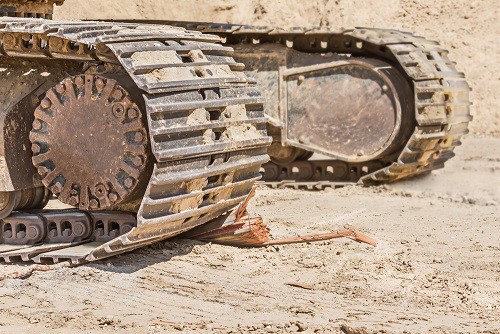
If you’re considering getting a new mini excavator, you may be wondering what the advantages are of steel tracks in comparison to rubber tracks. They each have their pros and cons and ultimately they have different applications depending on the nature and stage of each project.
Put simply, rubber tracks offer more versatility while steel tracks offer greater durability. Below we’ll look at how these advantages apply to specific situations during construction projects to help make the decision easier.
Traction
Rubber tracks have a noticeable traction advantage over steel tracks on most surfaces. Rubber has a higher intrinsic friction and melds to uneven surfaces, increasing the overall surface area. On any relatively smooth, dry surface, rubber tracks will have the advantage.
Rubber tracks can operate over concrete and asphalt without wearing or damaging, something steel tracks cannot do because they are heavier and harder. This makes them ideal for construction projects that are in the late stages of development. Rubber track excavators can access job sites connected to finished landscaping or existing pavement.
Steel tracks gain a traction advantage over rubber in harsher types of terrain and environments. For example, steel tracks can bite and hold onto muddy surfaces that rubber tracks would simply spin on. The rigid steel can push a vehicle over extremely uneven surfaces where a rubber track would slip while conforming to it.
Durability
Steel tracks excel when it comes to durability. The strong, rigid material sheds off contact with the many sharp and hard surfaces normally found on a construction site. Steel tracks are physically resistant to environmental materials as well as being far less likely to be damaged from chemicals.
Rubber can literally be dissolved or damaged by many chemicals and materials found on the job. Even oil and grease can damage rubber tracks. Rubber tracks also require a lot more general maintenance in terms of checking and adjusting tensions and ensuring it’s clean. Unlike rubber tracks, steel tracks have slack in their system, allowing rocks and other debris to be naturally expelled.
Comfort
Rubber tracks flex and conform to the terrain, generally meaning the ride is a lot more comfortable for the operator. Steel tracks tend to cause far more jarring, which can fatigue the operator. Steel tracks are also very loud, which could be a positive in terms of warning work crews and passersby that heavy machinery is being operated, but it can also be bothersome for the on-site crew.
Choosing a Track
In most cases, there is a great deal of overlap in terms of what can be done with either rubber or steel tracks. In many cases, they’ll perform the same job with the same efficiency and quality. Choosing between them is a matter of judging which option suits the specific circumstances of your construction project.
If you’re working around particularly jagged rocks, mud and thick brush, the advantages of steel tracks are unquestionable. Steel track loaders are generally more expensive, while rubber track loaders are more commonly used and widely available.
For All Your Mini Excavators and Construction Equipment
If you need rubber or steel track loaders in Brisbane, get in touch with the team at Allclass Construction Equipment. We offer a range of high quality new and used construction machinery and can advise you about the best track type for your construction project. For new or used construction equipment, call us on 1300 255 252 or contact us online.